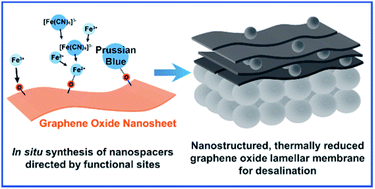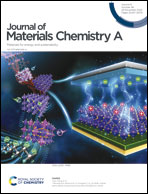A thermally reduced graphene oxide membrane interlayered with an in situ synthesized nanospacer for water desalination†
Abstract
The interlayer nanostructure of two-dimensional lamellar membranes is important with regard to efficient water permeation and purification. In this work, a new strategy of site-directed incorporation of Prussian blue (PB) nanoparticles into a thermally reduced graphene oxide (rGO) lamellar membrane was developed to enable high water flux for desalination. The membrane was based on the in situ synthesized GO/PB composite nanosheets and a subsequent thermal reduction. In this way, nanoparticles were uniformly coordinated to functionalized regions, while supporting the nanoscale water channels. Moreover, the interlayer distances between the pristine graphene areas were enlarged. This structure simultaneously mitigated the water transport resistance from the remaining oxygen-containing groups and increased the water permeation at the particle-free surfaces. As a result, the composite membrane showed 25 times higher flux than the unmodified rGO membrane and a remarkably competitive evaporation-based desalination performance compared with other state-of-the-art membranes. The applicability of this strategy for producing nanostructured lamellar membranes in high-performance desalination is thus demonstrated.



 Please wait while we load your content...
Please wait while we load your content...